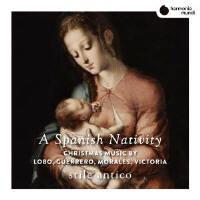Texte paru dans: / Appeared in: Harmonia Mundi
|
|
|
Outil de traduction (Très approximatif) |
|
|
Reviewer: Fabrice Fitch Released in time for Christmas, Stile Antico’s latest offering explores the Spanish Golden Age from Morales to Victoria. The centrepiece is the Mass by Alonso Lobo, based on a motet by his master, Francisco Guerrero, with a few seasonal vilancicos by way of palatecleansers. While the Mass is not explicitly for Christmas, the parent motet’s emphasis on Mary as the begetter of the Christ child makes it a plausible choice. In any case it’s a lovely work, opulent yet graceful, and one welcomes a second performance of it on disc (La Grande Chapelle recorded it six years ago – Lauda Música, 3/14 – but with soloists and chamber organ rather than several singers to a part, as here). In the sacred music, Stile Antico deliver performances of admirable contrapuntal clarity, sonic bloom and opulence; devotees of their approach won’t be disappointed (‘oh what a lovely song!’) or the rapidity with which the music changes tack. Given the music’s overt staging (only recall how Ensemble Clément Janequin dealt with such things), such forbearance is positively frustrating. (For another comparison across the years, try the Taverner Consort’s sophisticated lack of cultivation in their Ríu ríu chíu from their first ‘Carol Album’ – EMI/Warner, 12/89.) And I’d say something similar about the sacred music. The funereal tempo chosen for Victoria’s famous O magnum mysterium gives the singers little scope to shape melodic lines: it may be meant to evoke a world standing still in wonder but there are more dynamic ways of projecting a sense of interiority. This runs the risk of just being dull. Technically flawless as these performances typically are, a detailed musical response is too often missing or underdrawn: surely the startling chromaticism at ‘Crucifixus’ in the Mass calls for a sharper differentiation of the semitones at this point (after all, the composer could hardly have signposted his intention more clearly). To get to the point, a beautiful sound is an undeniable achievement, but on its own it cannot render a full account of what this music does or can do. For what it’s worth, the concluding Morales Cum natus esset Jesu gets closer to what I’d ideally have in mind. Fabrice Fitch. They could hardly dispute, however, that the secular pieces come off second best. Sensibly, Stile Antico take most of these with single voices, which is surely correct; but then one would expect a far greater projection of the text’s affects. In Flecha’s Jubilate Deo, the Virgin’s colourful language in facing down Satan elicits little discernible response. The same goes for the narrator’s occasional asides to the audience (‘oh what a lovely song!’) or the rapidity with which the music changes tack. Given the music’s overt staging (only recall how Ensemble Clément Janequin dealt with such things), such forbearance is positively frustrating. (For another comparison across the years, try the Taverner Consort’s sophisticated lack of cultivation in their Ríu ríu chíu from their first ‘Carol Album’ – EMI/Warner, 12/89.) And I’d say something similar about the sacred music. The funereal tempo chosen for Victoria’s famous O magnum mysterium gives the singers little scope to shape melodic lines: it may be meant to evoke a world standing still in wonder but there are more dynamic ways of projecting a sense of interiority. This runs the risk of just being dull. Technically flawless as these performances typically are, a detailed musical response is too often missing or underdrawn: surely the startling chromaticism at ‘Crucifixus’ in the Mass calls for a sharper differentiation of the semitones at this point (after all, the composer could hardly have signposted his intention more clearly). To get to the point, a beautiful sound is an undeniable achievement, but on its own it cannot render a full account of what this music does or can do. For what it’s worth, the concluding Morales Cum natus esset Jesu gets closer to what I’d ideally have in mind. |
|




